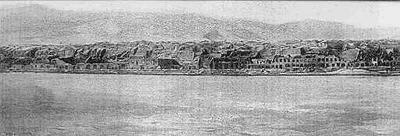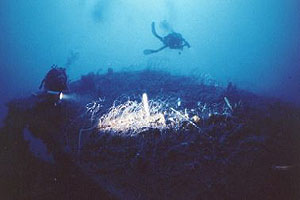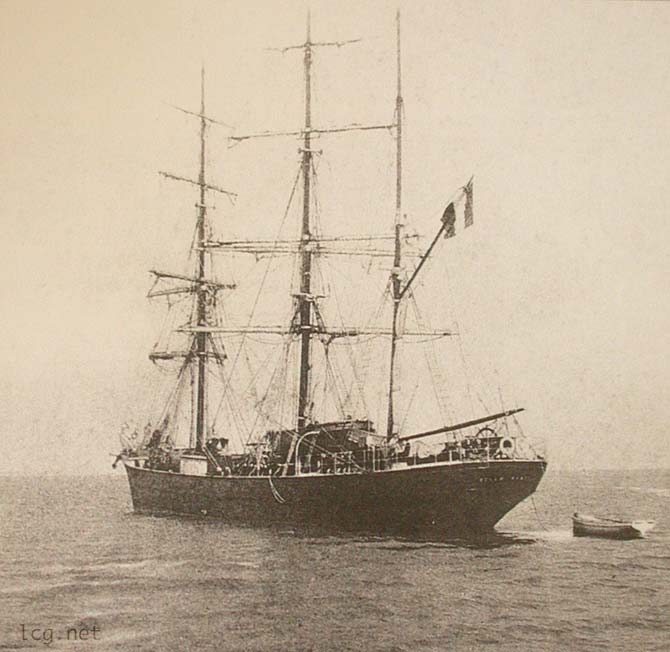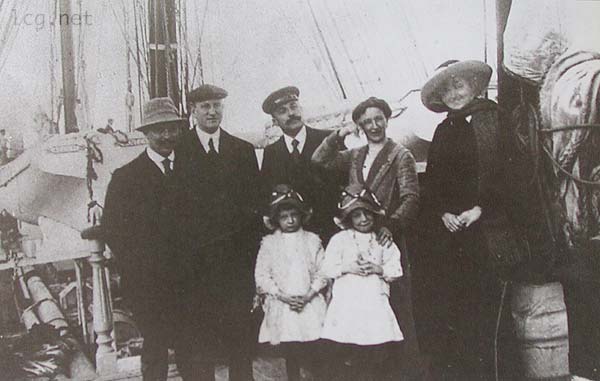1901-1914. Chauvelon’s years.
1899-1900, sixth to eighth voyage
Julien Chauvelon, young twenty four years old captain, succeeded Dolu. He leads the Belem to the Bristol’s canal to take a load of coal, then sailed to Pará. Upon arrival, the shipowner asked him (through Captain Obalski, Crouan’s agent of in Brazil) to take command of the Claire-Menier already loaded with cocoa and without captain (the previous one died of yellow fever).
Captain Lesage came to relieve Chauvelon to bring back the Belem. Chauvelon was supposed to get back the boat at her return in Nantes, but Lesage’s crossing to France took so long that Chauvelon had to take again command for the Claire-Menier.
It was then Chauvelon’s turn to be delayed by the collision of the Claire-Menier by an Italian liner. Lesage having taken back command of the Denis-Crouan, it was Captain Le Dantec that took the command of the Belem for the beginning of the seventh voyage of the boat (Nantes - Saint-Nazaire - Buenos-Aires - Martinique - Nantes). Chauvelon should this time get back the Belem in Buenos Aires but Claire-Menier is again behind. Belem has even the time to do a voyage with Dantec (Nantes - Cardiff - Belém - Nantes) before Julien Chauvelon could finally get on her board and take her command on November 25th, 1900, for numerous years this time.
Story of these to-ings and fro-ings by Louis Lacroix:
My colleague, Mr. Julien Chauvelon, succeeded him and left to take a full load of coal in the Bristol’s canal for Pará; hardly arrived, the captain Obalski, representing Mr. Denis Crouan, asked him to land to take Claire-Menier’s command, already loaded, but which captain, Mr Molay, died of yellow fever as part of his crew. It was agreed that he would get back the Belem after my old companion Lesage, landing for this command of the Denis-Crouan, would return in Europe. But Lesage, opposed by calms and bad weather, took fifty eight days to get back to Nantes and Mr Chauvelon, arrived for several weeks already, had to leave with the Claire-Menier for Buenos Aires with coal and a real to-ings and fro-ings began.
Claire-Menier was hit on the equator by the Italian liner Menapi from Bari and Mr Chauvelon had to stop to the Cape Verde’s islands to install a makeshift masting to get back to Nantes, where he arrived on February 17th, 1900. The Belem, during this time, had to sail again under the command of Captain Le Dantec, Mr Lesage having resumed his command of the Denis-Crouan, and she left Saint-Nazaire on ballast on November 17th, 1899 for Buenos Aires where she waited for Mr Chauvelon and for the Claire-Menier until February 1st. Because of the delay of this vessel, her shipowner made the Belem cross to Martinique, from where she returned to Nantes and had even the time to do a complete voyage Cardiff-Pará-Nantes, from August 11th till November 25th, 1900, date when Mr Chauvelon was finally able to resume his command. [Louis Lacroix, on 1945].
Julien Chauvelon’s romanced story by Jean Noli:
Son of sailor, borned February 11th, 1875 in Rezé, on the left bank of the Loire, he is first lieutenant aboard of the Reine-Blanche on which he doubles the Cape Horn, then second officer on the Marguerite-Arnhaud, when the Crouan hires him. The Belem is his first command: he is 26 years old.
Unlike his predecessors, stout and sturdily built, Chauvelon has a slender, almost thin silhouette. But the appearance is misleading: under the black suit which he almost never leaves, the man is tough and solid. The brown hair combed back, the oval face, the straight and thin nose and at the end, the thick mustache, always elegant, he is attractive and the inhabitants of Nantes who see him going in a hurry towards the offices of his shipowner find him a lot of charm. But the sailor has only two passions: the sea and her wife, slim and graceful, who gave him two children, Olivier and Jeanne. [Jean Noli, 1996].
1901-1902, the Chauvelon’s first three campaigns
These first three campaigns are without problems.
The first, Nantes / Pointe-à-Pitre / Nantes, in 146 days from January 12th till June 4th, 1901. Load of sugar.
The second, Saint-Nazaire / Belém / Nantes, in 87 days, from June 24th till September 17th, 1901. Load of cocoa.
The third, Nantes / Cap-Haïtien / Le Havre, in 116 days from October 30th, 1901 till February 23th, 1902. Load of sugar. It is the first time that the Belem didn’t go back to Nantes.
May 8th, 1902, the disaster of Mont Pelée
Chauvelon’s fourth campaign aboard the Belem is a voyage to Martinique from Le Havre with a return in Nantes (from March 19th till August 6th, 1902).
He [the captain Chauvelon] was on board in the harbour of Robert during the disasters of May 8th and 26th, 1902 when the eruption of Mont Pelée destroyed Saint-Pierre-de-la-Martinique making forty thousand victims. Two French three-masters, the Tamaya of Nantes, Captain Mahée and the Biscaye, Captain Trévilly, went down with all hands during the disaster and the Belem, which was only thirty kilometers as the crow flies of the terrible volcano, was able however to escape the disaster. But the bridge was covered with ashes and pebbles, her rigging and her masting underwent some damages; the thick coat of volcanic dusts was transformed some hours later by torrential rain into a caustic and thick mud difficult to remove, as hard as a mortar. [Louis Lacroix, 1945].
At this beginning of May, 1902, the Belem arrived in the harbour of Saint-Pierre but its place was taken by the sailboat Tamaya (Captain Mahée) of shipowner Rozier of Nantes. This small incident is going to save the Belem.
Le Tamaya
3 mâts carré de 566 tonneaux de jauge brute (pour réf. Belem : 527 tonneaux).
Construit en fer en 1862 aux chantiers de Liverpool.
Immatriculation au long cours n°356. Armement Rozier, Nantes.
Armé le 18 février 1902 pour la Martinique.
Perdu corps et biens le 8 mai 1902. Rayé de l’effectif de la Marine Marchande le 21 juillet 1902.
Commandant : Théophile Mahéo, né le 30 août 1860 à l’île aux Moines.
Rôle d’équipage :
Charles Le Cerf, second capitaine.
Joseph Sujet, bosco.
Gabriel Le Ian, cuisinier.
Jean Goubeyre, Michel Gallard, Yacinthe Lab, Pierre Rouxel, J.-Marie Peyraud, Alexis Auvray, Frédéric Mallert, Pierre Gallapel, Raymond Crequier.
Chauvelon had to go cast anchor to Robert, on the other side of the island.
In this time, Saint-Pierre was the capital of Martinique and the economic centre of the West Indies. Nicknamed Small Paris, it was a pleasant city. One of its prides was the italian-styled theater presenting various shows, the exact replica of Bordeaux’s theater. It had also a world-famous botanical garden. Mont Pelée, depicted as an extinct volcano without danger for the population, was a touristic sight.
From February 1902, different outward signs of the volcano should have pull the alarm. Showers of ashes had already covered Saint-Pierre. Schools were closed since May 3rd. The population waited in the anxiety. Some fleed. Worried more by the organization of the second tour of the general election which should take place on May 11th, the authorities tried to reassure the population. On May 5th, Guérin’s sugar refinery, located three kilometers from the city, is destroyed by a mudslide, making numerous victims. A tidal wave follows on the natural harbour.
The harbour regulations forbade captains to weigh anchor without authorization. On May 7th, a man nevertheless, Captain Ferrata, commanding the Orsolina, decided to leave. The boat was already covered with ashes. He knew well the angers of the Vesuvius and he saw the danger. Customs refused to let him leave, and threatened him of heavy penalties if he weighted anchor nevertheless. He left them by answering: “Who will apply them to me? Tomorrow, you will all be dead!”. The boat will be the only survivor of those that were in harbour.

On May 8th, at 8 o’clock, Saint Pierre was completely destroyed. Just in few seconds, an enormous burning mass rushed over the city, covered it, suffocated it, put fire to it then ran over the sea. The city is plunged into the darkness. Nothing was spared.
Chauvelon was ready to land to go on horseback to Saint-Pierre, lunch with the Captain Mahée. The noise of the explosion and the spectacle of the panache of smoke attracted all crewmen to the bridge. A shower of ashes arrived on the Belem.
The candidates for the general election, Fernand Clerc and Louis Percin had already fled the city at 6.30. About 28 000 inhabitants died suffocated and burned. Of this tragedy, only two survived: Léon Compère and the well-known Louis Auguste Sylbaris, said Cyparis.

The Tamaya’s remains are one of the rare remains of the harbour that was identified because a bell, bearing the inscription Tamaya 1862, was brung back up to surface in 1984 by Dominique Serafini. This bell was handed to the volcanologique museum of the City of Saint-Pierre.
Below, the wreck of the Tamaya in 2001 (photo JP Plongée):

The Belem, loaded with sugar, cleaned by its ashes, leaves her shelter on August 6th.
Eight campaigns in the “West Indies” are going then to succeed one another without dramatic events from 1902 till 1907:
- Nantes / Cardiff / Trinidad / Haïti / Nantes,
- Nantes / Cayenne / the Barbados / Haïti / Nantes,
- Angleterre / Guadeloupe / Nantes,
- Saint-Nazaire / Belém / Nantes, from June 3 to September 3, 1904, with as passenger, the wife of Julien Chauvelon by way of honeymoon trip,
- Saint-Nazaire / Belém / Martinique / Nantes,
- Saint-Nazaire / Martinique / Nantes,
- Saint-Nazaire / Belém / Nantes,
- Saint-Nazaire / Cayenne / Connétable.
1907-1908, the Demange’s interlude
On Mr Crouan’s death, at the age of 85, his son-in-law took his business back, but the Menier’s factory in Noisiel decided to import its cocoa through Le Havre, closer to the factory. Deprived of its usual freight and undergoing the competition of steamers, the shipowning company was liquidated in 1906.
The Belem was acquired the shipowners Demange Frères for their line of Cayenne. In this occasion, the colour of her hull changed from black to grey with a line of sham ports.
Chauvelon remained her captain but the goods are not anymore the same: goodbye she-mules and sheeps, place to more heterogeneous loads charged in Nantes. A matter of providing supplies the famous territory for its penal colony.
After her unloasing in French Guyana, the Belem didn’t return directly to Nantes because there was no freight to be brought back from this colony which produced few things. She will make stopovers during her three voyages under Demange’s name so successively to the island of Aruba, to Martinique and finally to the Barbados. Of these voyages, she bring back in France sugar for the chocolate factory Menier.
After these three campaigns, the shipowning company Demange Frères was also liquidated.
1909-1914, Fleuriot’s years
Further to the liquidation of Demange Frères, the Belem was to sell. The Société des Armateurs Coloniaux, property of Fleuriot et Cie and Mr Pitre-Rozier, purchased her and keeping her captain, her crew and her line (French Guyana and the West Indies).
Le Belem adopte une livrée gris foncé. La ligne de faux-sabords de l’armement Demange disparaît.
The crew, with the exception of a ship’s boy, did not change. Boatswain and sailors were always the same. In a letter sent to its family, Briaud (the boatswain) wrote not without a certain naive pride: “the boat is served by a crew which is what is the best in Nantes and even somewhere else: there are never incidents or wounded persons on board.” [Jean Noli, 1996].

Observe on this photography of Fleuriot’s years the division of the mizzen mast (due to appearance of a gaff).
Document: Rapport de mer du commandant Chauvelon, le 21 février 1913.
1913-1914, the thirty-second and last campaign
From September 6th, 1913 till January 31th, 1914, the Belem made her last voyage for business purposes.

The captain Chauvelon (in the centre), his wife, and their two children: Olivier and Jeanne, on the poop of the Belem, at feet of the mizzen mast. Photography probably taken in the beginning of September, 1913, from the last campaign of the Belem (Nantes, Fort-de-France, Aruba, Nantes).
The destination was Fort-de-France. On board, there was passengers of exception: Madam Chauvelon, the captain’s wife, Jeanne and Olivier, their two children as well as Constance, the governess. It was not the first journey of Madam Chauvelon on board, she had already made her honeymoon trip on it a dozen years before.
The captain Chauvelon surely knew that he will have to abandon his dear boat and doubtlessly, he wanted to share this last campaign with his entire brood.
The Belem was back in Nantes on January 31th, 1914, after a stopover to Aruba where it loaded phosphates.
Of all the “Antillais”, the Belem was one of the last ones still working at that time. The world changed, steamers dethroned the big sailboats and the first world war will be almost fatal to the rest of the fleet with masting and sails. Thanks to the beauty of her lines, her future usage of luxury yacht will save her from swashbucklers and Germans.
Document : Tableau récapitulatif des 32 campagnes au commerce.
Navigation
© 2001-2011 Laurent Gloaguen | dernière mise à jour : octobre 2016 | map | xhtml valide.
